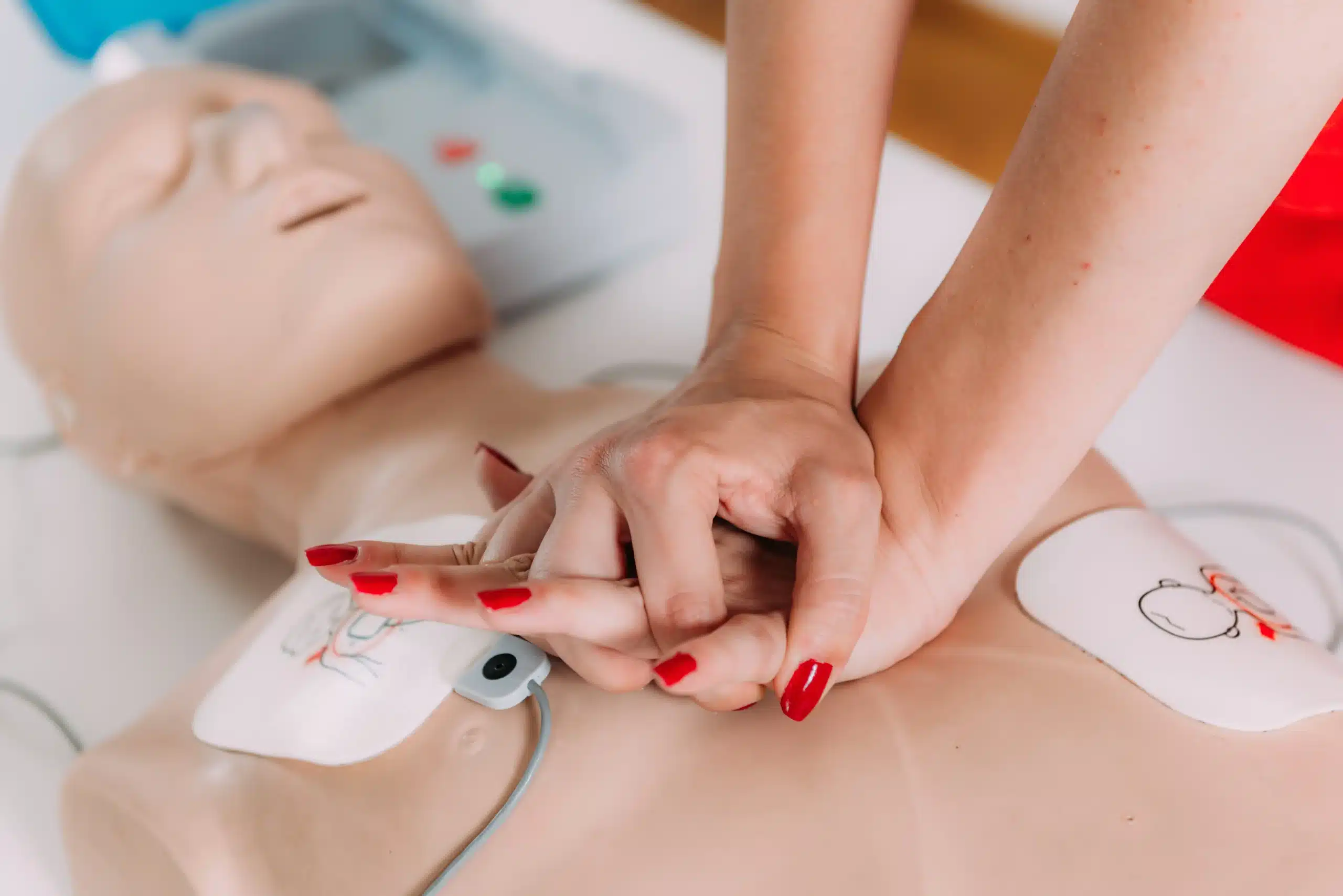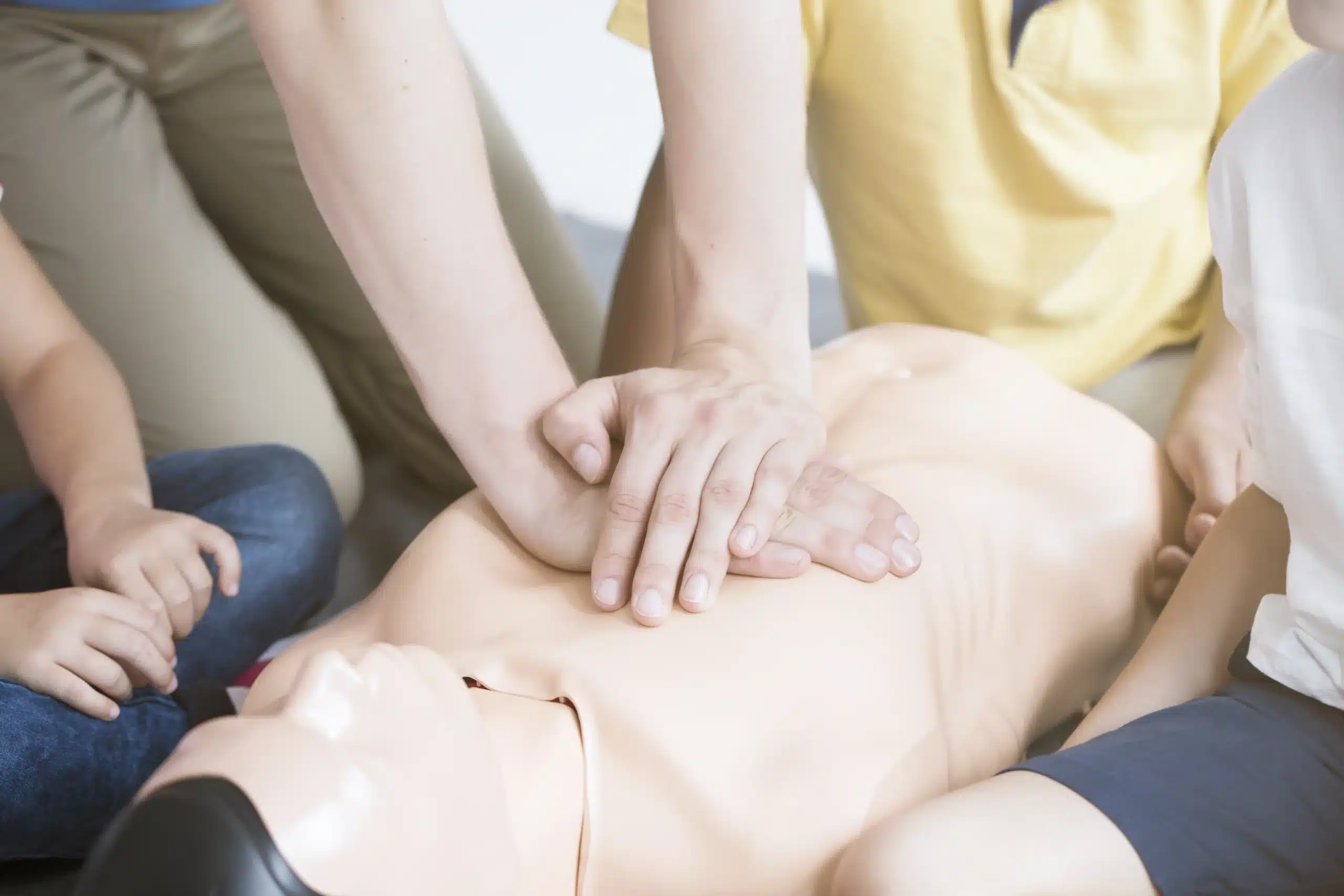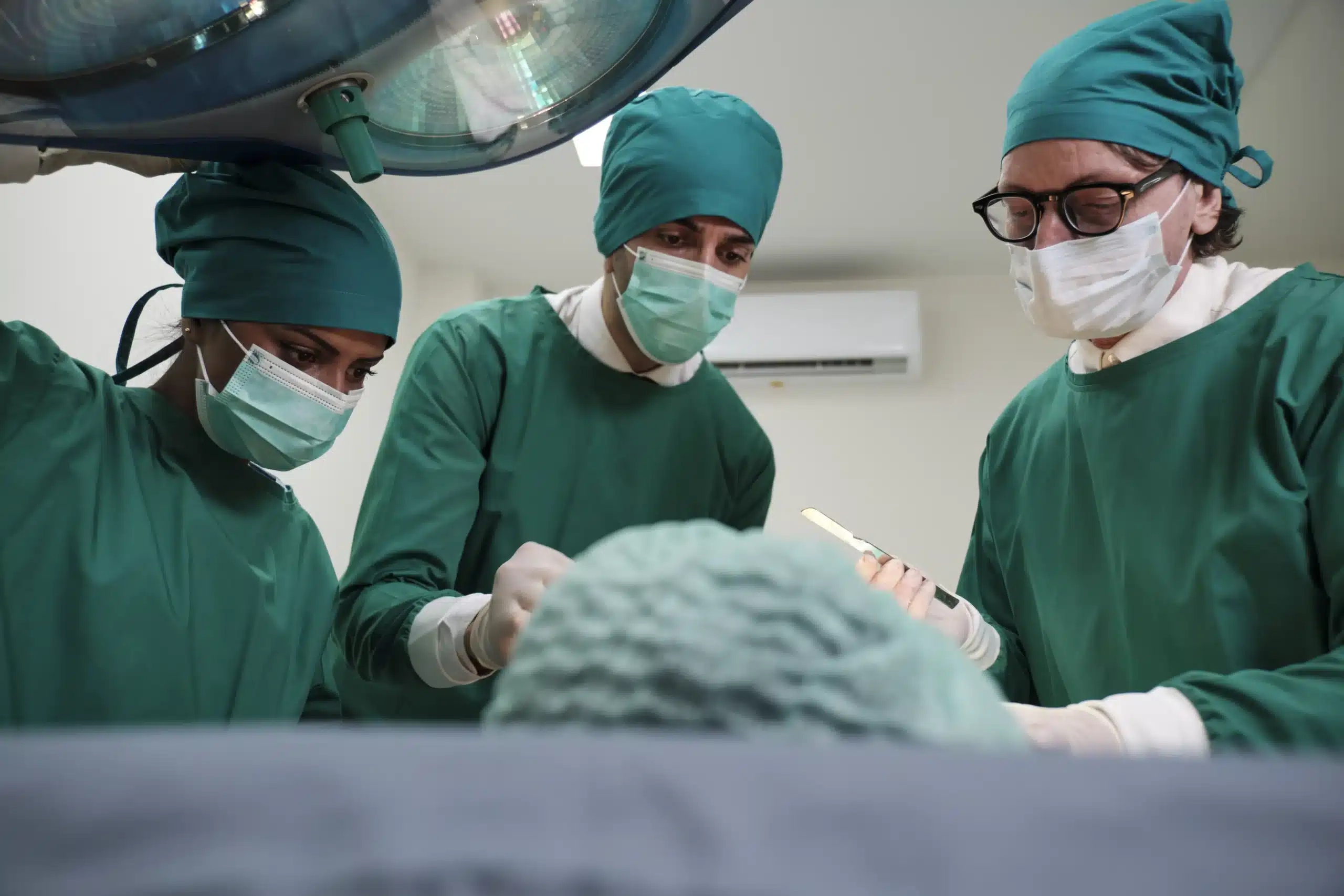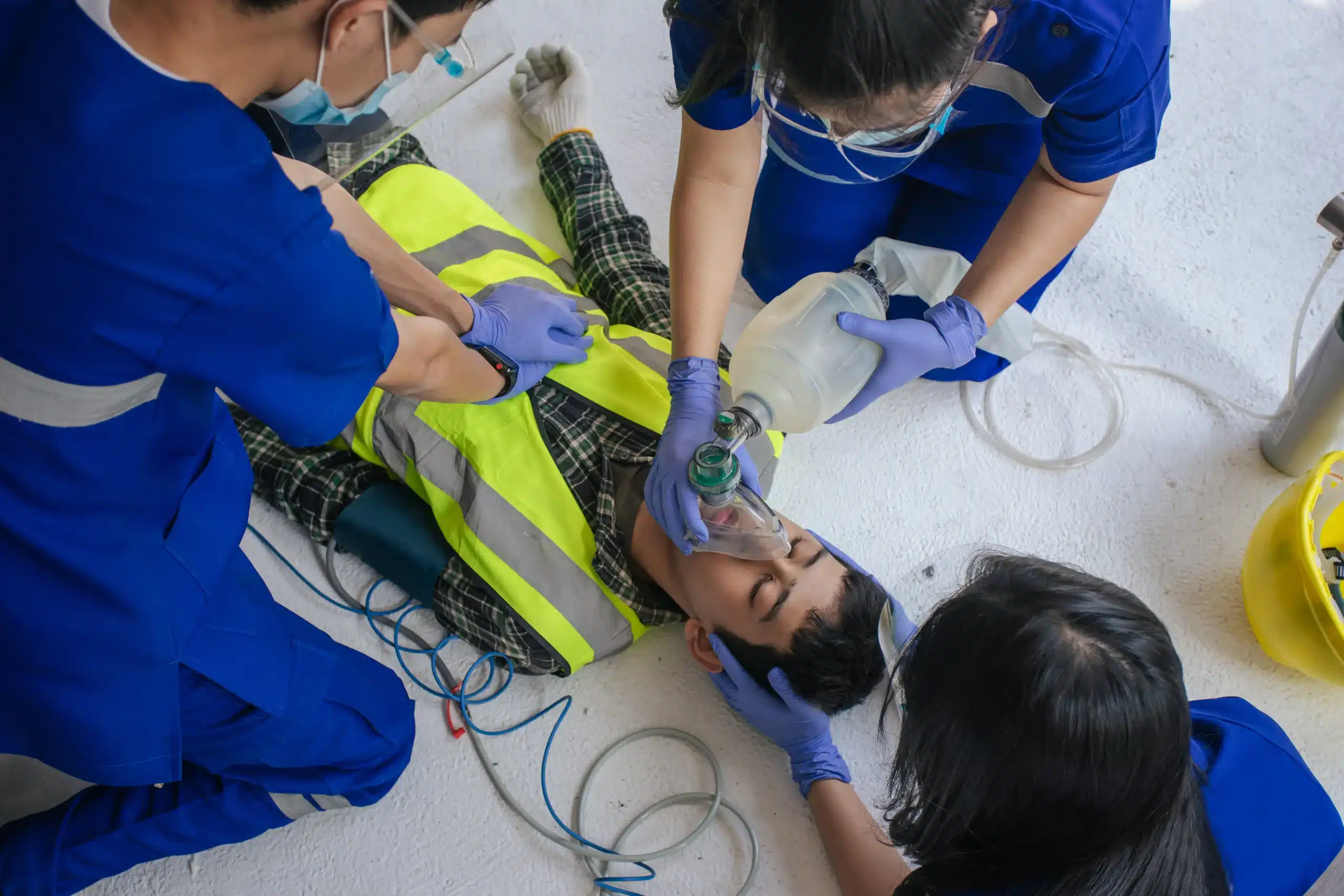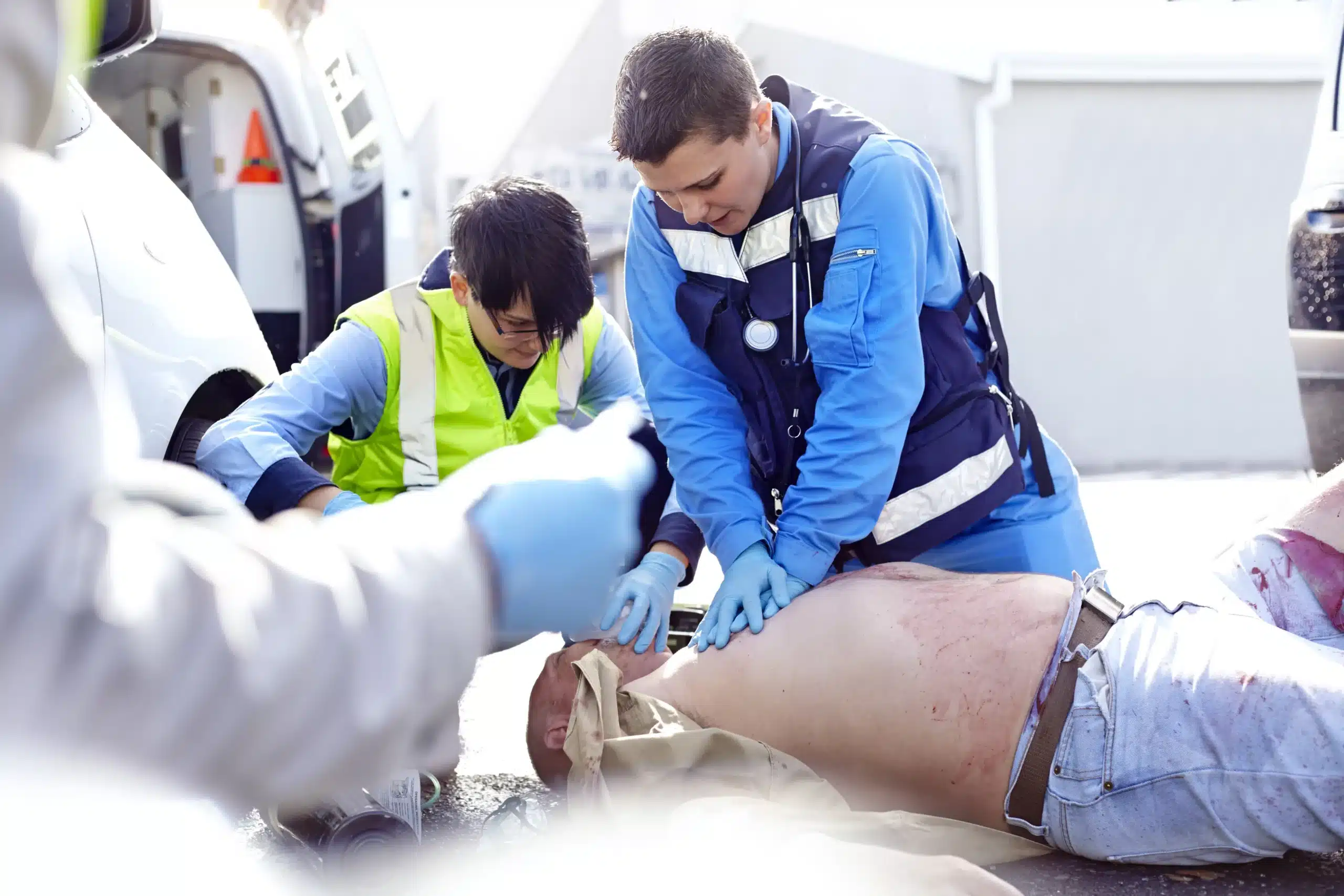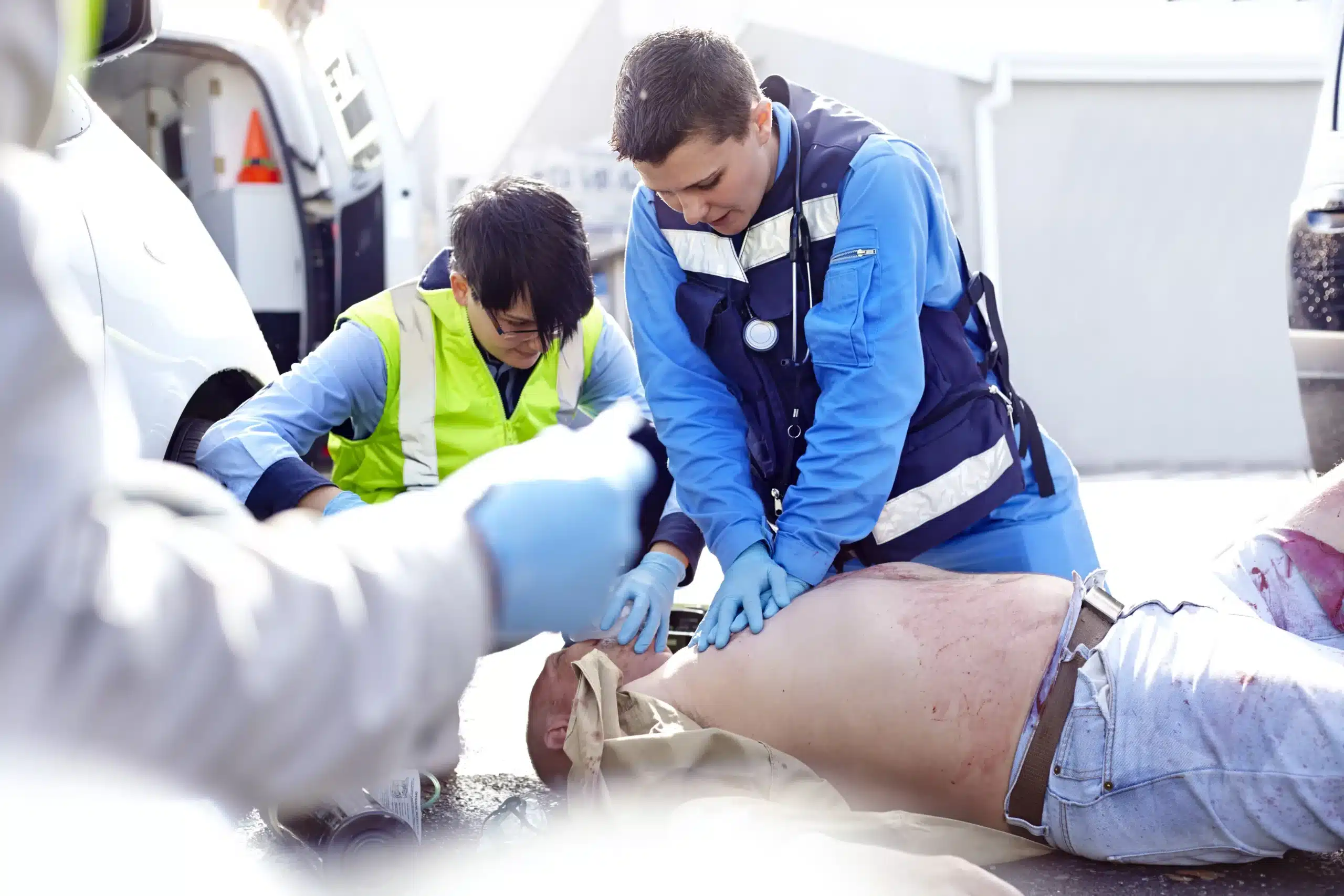Working in healthcare in Union City means being prepared for anything. BLS for healthcare providers in Union City provides the essential skills and confidence to handle medical emergencies effectively. But what exactly does BLS certification entail, and why is it so important for healthcare professionals? This post breaks down the key aspects of BLS training, including the skills you’ll learn, the difference between BLS and standard CPR, and how it can advance your career. We’ll also guide you through finding reputable BLS certification courses in Union City and offer tips for preparing for your training.
Key Takeaways
- BLS certification provides essential skills for healthcare professionals: It goes beyond standard CPR, encompassing advanced techniques and a strong emphasis on teamwork in medical emergencies. Find a reputable provider offering AHA-compliant courses.
- Choosing the right BLS course matters: Consider factors like accreditation, instructor experience, and schedule flexibility when selecting a course. Blended learning options can provide a convenient way to gain both theoretical knowledge and practical skills.
- Maintaining your BLS skills is crucial: Regularly review the latest guidelines and seek out continuing education opportunities to stay sharp. Plan ahead for renewal requirements to avoid lapses in your certification and ensure you’re always ready to respond effectively.
What is BLS for Healthcare Providers?
Basic Life Support (BLS) certification is a vital credential for healthcare professionals. It equips providers with the skills to respond effectively to life-threatening emergencies, focusing on immediate intervention and high-quality CPR. This training goes beyond standard CPR, encompassing a wider range of life-saving techniques for cardiac arrest, respiratory distress, and obstructed airways. For many healthcare roles, BLS certification is often a requirement.
What is BLS and Why is it Crucial?
BLS training emphasizes the importance of teamwork in medical emergencies. Healthcare providers learn to work as a cohesive unit, coordinating their efforts to deliver timely and effective care. Clear communication and collaboration are essential components of successful resuscitation, and BLS courses stress these skills alongside the physical techniques. This focus on teamwork ensures that everyone involved can contribute effectively in high-pressure situations. The importance of BLS training for healthcare professionals cannot be overstated, as it directly impacts patient outcomes. Every healthcare professional needs this training to provide the best possible care during crises.
Key BLS Training Components
BLS courses cover core resuscitation techniques, including chest compressions, rescue breaths, and using automated external defibrillators (AEDs). The curriculum also emphasizes critical thinking, problem-solving, and rapid decision-making in dynamic emergency scenarios. Training is regularly updated to reflect the latest American Heart Association guidelines, ensuring providers learn the most current and effective methods. This comprehensive approach prepares healthcare professionals to manage various emergencies with confidence and competence. BLS training equips healthcare providers with essential, life-saving skills they need every day.
Common BLS Certification Misconceptions
One common misconception is that BLS and CPR certification are the same. While BLS includes CPR, it provides a broader skill set specifically designed for healthcare providers and first responders. Another misconception is that BLS certification is universally required for all healthcare roles. The necessity of BLS certification varies depending on the specific job and employer requirements. It’s essential to research the specific requirements for your desired healthcare profession or consult with your employer to determine whether BLS certification is necessary.
Find BLS Certification in Union City
Several organizations offer BLS certification courses in and near Union City. Choosing a reputable provider with high-quality instruction and a convenient location is essential. Here are a few options:
Hayward CPR Classes
Hayward CPR Classes offers American Heart Association (AHA) BLS courses, along with other certifications like ACLS, PALS, and First Aid. They provide group discounts and offer competitive pricing in Alameda County. Serving Hayward, Union City, and San Leandro, their focus on AHA courses makes them a good option for healthcare providers.
American Red Cross
The American Red Cross provides BLS training for healthcare providers, offering both in-person and blended learning (online and in-person) options. This flexibility accommodates busy schedules. Visit their website for course availability and registration.
BLS Test Center
BLS Test Center specializes in BLS training, using techniques developed by experts at the Sarver Heart Center. They teach procedures used by organizations like the American Red Cross and AHA. Learn more about their Union City BLS classes.
CPR Education
CPR Education offers various CPR and first aid classes, including AHA courses and BLS certification in Union City and surrounding areas. They work with individuals and groups and can arrange on-site training for businesses.
In Home CPR
In Home CPR specializes in bringing the training to you. They offer BLS certification classes in Union City with no minimum number of participants, a convenient option for small groups or individuals.
San Leandro CPR Classes
While located in San Leandro, San Leandro CPR Classes serves Union City. They offer comprehensive BLS certification courses covering CPR for adults, children, and infants, AED use, and choking relief, adhering to AHA guidelines.
Get BLS Certified
Getting your BLS certification is straightforward, and several options are available to fit your schedule and learning style. Here’s what you need to know about course formats, exams, and choosing between online and in-person training.
Course Duration and Format Options
BLS courses for healthcare providers are typically offered in two formats: in-person classes and blended learning, which combines online coursework with an in-person skills session. This hands-on component allows you to practice your skills and receive feedback from a certified instructor. The American Red Cross offers both options, allowing you to choose the format that best suits your needs. Traditional in-person classes provide a structured learning environment, while blended learning offers more flexibility for busy schedules.
Exam Requirements and Passing Criteria
BLS courses typically include a written exam and a practical skills test. The written exam assesses your knowledge of BLS principles and procedures. The practical skills test evaluates your ability to perform CPR, use an AED, and provide other life-saving interventions. You’ll need to demonstrate competency in both areas to receive your BLS certification. Upon successful completion, you’ll receive a digital certificate, often valid for two years, providing convenient access to your credentials and training history.
Online vs. In-Person Training
Both online and in-person BLS courses cover the same core content, including resuscitation techniques, critical thinking, teamwork, and decision-making. The curriculum is regularly updated to reflect the latest guidelines. Many training providers, like SureFire CPR, integrate CPR training directly into their BLS courses, ensuring you gain comprehensive life-saving skills for adults, children, and infants. The best format depends on your learning preferences. Some people thrive in the interactive setting of an in-person class, while others appreciate the self-paced nature of online learning.
BLS Certification: Cost & Value
Average Price Range in Union City
Knowing the typical cost of BLS certification in Union City helps you budget effectively. While prices can fluctuate, you can generally expect to find BLS Provider courses between $70 and $90. This covers the training, materials, and certification fees. CPR/AED/First Aid certification, which is often a prerequisite, usually falls in the $60 to $80 range. Contacting providers directly, like Hayward CPR Classes, will give you the most accurate pricing.
Factors Affecting Course Costs
Several factors contribute to the final cost of a BLS certification course. The training center’s location plays a role, as prices can differ between cities and even neighborhoods. The instructor’s experience and the course format (in-person vs. blended learning) can also influence the price. Some courses might include additional materials or resources, impacting the overall cost. Finally, whether you’re pursuing initial certification or recertification can also affect the price. Learn more about BLS course content from the American Heart Association.
Discounts and Promotions
Looking for ways to save on your BLS certification? Many training centers offer discounts, especially for group registrations. If you’re registering with colleagues or friends, inquire about group discounts at Hayward CPR Classes. Some providers also offer discounts for students, military personnel, or first responders. Checking a training center’s website or contacting them directly about ongoing promotions is always worthwhile.
BLS vs. Other CPR Certifications
Understanding the different types of CPR certifications can be confusing. This section clarifies the distinctions between BLS and other common certifications like standard CPR, ACLS, and PALS. Knowing the differences will help you choose the right course for your needs.
BLS vs. Standard CPR
Basic Life Support (BLS) certification goes further than standard CPR training. While both teach the essentials of CPR—chest compressions, rescue breaths, and how to use an AED—BLS adds another layer of skills. BLS is designed for healthcare providers like doctors, nurses, paramedics, and other professionals who may respond to emergencies in a medical setting. It includes training on advanced airway management, bag-mask ventilation, and team dynamics during resuscitation. Standard CPR training is suitable for anyone wanting to learn lifesaving skills, but BLS provides the specialized knowledge and techniques required in professional healthcare environments. Think of standard CPR as the foundation, and BLS as the next level up, specifically tailored for healthcare professionals. You can find more information on the differences between BLS and CPR here.
BLS vs. ACLS and PALS
BLS, ACLS (Advanced Cardiovascular Life Support), and PALS (Pediatric Advanced Life Support) are all designed for healthcare providers, but they address different levels of complexity. BLS certification provides the core skills for managing respiratory and cardiac arrest. ACLS and PALS certifications build upon those core skills, focusing on more complex situations. ACLS teaches advanced techniques for managing adult cardiac emergencies, while PALS focuses on the specific needs of infants and children. If you work in a critical care setting or regularly respond to cardiovascular emergencies, ACLS or PALS certification may be necessary in addition to your BLS training. Many healthcare providers find it beneficial to hold all three certifications to be fully prepared for a range of emergency situations. You can learn more about BLS for healthcare providers here.
What to Expect in a BLS Course
Getting your BLS certification is more than just a checkbox; it’s about equipping yourself with the skills to potentially save a life. Here’s a glimpse into what awaits you during your BLS training:
Core Skills You’ll Learn
BLS courses revolve around a core set of life-saving skills. You’ll learn how to perform high-quality CPR for adults, children, and infants, including chest compressions, rescue breaths, and maintaining a proper rhythm. The course also covers using an automated external defibrillator (AED) and what to do if someone is choking. Teamwork and communication are vital in emergencies, so you’ll practice clear communication and coordination. These skills are crucial for healthcare providers, and the training provides a solid foundation for providing effective care. Learn more about our BLS certification course.
Hands-on Practice
BLS courses are far from just lectures and videos. You’ll spend significant time practicing the skills you learn, with hands-on training using mannequins to build muscle memory and confidence in performing CPR and using an AED. This practical experience is essential for applying classroom knowledge in real-world situations. Our instructors will guide you, providing feedback and ensuring you’re comfortable with the techniques.
Scenario-Based Learning
BLS courses often use scenario-based learning to prepare you for real-life emergencies. You’ll work through simulated emergencies, applying your skills in realistic situations to develop critical thinking and decision-making abilities under pressure. These scenarios might involve a cardiac arrest, choking incident, or other medical crises. Working through these scenarios reinforces your understanding of BLS protocols and builds confidence in responding effectively. Ask us about group discounts for scenario-based training.
Emotional Preparedness Training
While not always a primary focus, many BLS courses address the emotional impact of providing emergency care. It’s important to recognize that these situations can be stressful. Some courses may offer coping strategies for the emotional aftermath of a crisis. This aspect of training acknowledges the human element of healthcare and prepares you for potential emotional challenges. Find out more about our RQI classes for additional support.
Maintain Your BLS Certification
Once you’ve earned your BLS certification, staying current is key. Knowing the renewal process, exploring continuing education, and keeping up with the latest guidelines will ensure you’re always prepared to provide effective, high-quality care.
Renewal Requirements
BLS certification, like many healthcare certifications, isn’t a one-and-done deal. It requires renewal every two years. This ensures your skills and knowledge remain sharp. Check with your certifying organization, such as the American Heart Association, for specific renewal requirements. Plan ahead and be aware of upcoming deadlines to avoid any lapse in your certification. One common challenge is the cost of renewal courses, which can vary. Researching different options can help you find a course that fits your budget.
Continuing Education Options
Even if your renewal date isn’t approaching, regular training and refresher courses are a great way to stay at the top of your game. Think of it like any other professional skill—consistent practice leads to mastery. Look for opportunities to expand your knowledge and refine your techniques. Some employers and regulatory bodies may even require continuing education credits. Whether mandatory or not, pursuing additional training demonstrates your commitment to providing the best possible care. This can also be a smart move for career advancement, showing initiative and a dedication to lifelong learning. Explore various courses to find topics that align with your professional goals.
Stay Updated on Guidelines
Emergency cardiovascular care guidelines are constantly evolving, reflecting the latest research and best practices. Staying informed about these updates is crucial for maintaining your BLS proficiency. Regularly review the guidelines published by your certifying organization. These updates often include important changes to procedures, so staying current is essential for delivering effective care. Subscribing to newsletters or following relevant organizations on social media can help you stay informed about new developments. By staying on top of the latest guidelines, you’ll be confident in your ability to respond effectively in any emergency situation.
Benefits of BLS Training
BLS certification offers numerous advantages, especially for healthcare providers. It’s not just about getting a credential; it’s about gaining skills and confidence that can significantly impact your career and the lives of your patients.
Career Advancement
BLS training is often a prerequisite for many healthcare roles and demonstrates a commitment to providing high-quality patient care. As Kennesaw State University points out, BLS training is essential for healthcare professionals because it emphasizes teamwork in critical situations. This training prepares you to be a valuable member of any medical team. A BLS certification can open doors to more advanced training and specialized roles, ultimately enhancing your career.
Improve Patient Outcomes
BLS equips healthcare providers with the skills to respond effectively during life-threatening emergencies. Integrity Health Education discusses how BLS training directly translates to improved patient outcomes. By mastering techniques like CPR and recognizing the signs of cardiac arrest, you’re better prepared to deliver timely interventions that can significantly increase a patient’s chances of survival.
Enhance Teamwork and Communication
Effective communication and coordination are crucial in emergencies. All Hearts CPR explains how BLS training reinforces the importance of clear communication and collaboration among healthcare teams. This training helps build a shared understanding of protocols and procedures, allowing teams to work together seamlessly under pressure.
Build Confidence in Crises
Facing a medical emergency can be stressful. BLS training provides essential skills and helps develop the confidence to apply those skills effectively in high-pressure situations. The Online Safety Trainer website discusses how BLS training helps healthcare providers manage the emotional impact of providing care in these challenging circumstances. This confidence translates to quicker decision-making and improved patient care.
Choose the Right BLS Training Provider
Finding the right BLS training provider is crucial for a high-quality learning experience. Here’s what to consider:
Accreditation and Reputation
Look for a training center affiliated with a nationally recognized organization like the American Heart Association. This ensures the curriculum is up-to-date and evidence-based. A provider with a solid reputation, like Hayward CPR Classes, often signifies positive student experiences. Reading online reviews can offer helpful insights.
Instructor Qualifications
Experienced, certified instructors bring valuable knowledge and practical skills to the classroom. Ask about the instructors’ credentials and teaching experience. A skilled instructor can make all the difference in your understanding and confidence. Hayward CPR Classes has a team of qualified instructors dedicated to comprehensive training.
Course Scheduling Flexibility
A good training provider offers flexible scheduling. Look for options like weekend and evening classes, or blended learning formats that combine online modules with in-person skills sessions. This allows you to fit BLS training into your busy schedule. Hayward CPR Classes offers various class times to accommodate different schedules.
Blended Learning Options
Blended learning, combining online coursework with in-person skills practice, offers a convenient and effective approach. The online portion lets you learn at your own pace, while the in-person session provides hands-on training and instructor feedback. If this sounds appealing, explore the blended learning options available through Hayward CPR Classes.
Prepare for Your BLS Certification
Getting ready for your BLS certification involves more than just showing up for class. A little prep work goes a long way in building your confidence and preparing you to learn these lifesaving skills. Here’s how to prepare:
Study Materials and Resources
Before your BLS course begins, familiarize yourself with the core concepts. Organizations like the American Red Cross and the American Heart Association offer study materials and resources designed to complement their BLS for Healthcare Providers courses. These resources often align with guidelines from organizations like the International Liaison Committee on Resuscitation (ILCOR), ensuring you’re learning the most up-to-date practices. Check with your chosen training center, like Hayward CPR Classes, to see what pre-course materials they recommend. They may have specific resources tailored to their curriculum.
Practice for Skill Retention
BLS skills require regular practice. Think of it like any other skill—the more you use it, the more proficient you become. Even after you’ve earned your BLS certification, engage in regular training sessions and refresher courses. This ongoing practice keeps your skills sharp and ensures you’re prepared to respond effectively in a real-life emergency. Many providers offer refresher courses, making it easy to stay current. Check out the RQI classes offered by Hayward CPR Classes for a convenient way to maintain your skills.
Overcome Common Challenges
One of the most common challenges people face when pursuing or renewing their BLS certification is simply finding the time. Juggling work, family, and other commitments can make it tough to fit in a course. Look for providers like Hayward CPR Classes that offer flexible scheduling, including weekend and evening options. Another hurdle is cost. Reach out to Hayward CPR Classes to discuss potential discounts, especially if you’re registering with a group. Knowing what to expect and planning ahead can help you overcome these common challenges and successfully complete your BLS certification.
Related Articles
- BLS Renewal in San Leandro: Your Complete Guide – Hayward CPR Classes
- BLS Classes in Hayward: Your Complete Guide – Hayward CPR Classes
- CPR Myths Busted What Everyone Should Know
- CPR Renewal in Union City: A Complete Guide
- ACLS HeartCode San Leandro: Your Certification Guide – Hayward CPR Classes
Frequently Asked Questions
Is BLS certification the same as CPR certification? No. BLS builds upon the foundation of CPR, adding advanced skills like airway management and team dynamics specifically for healthcare providers. CPR training is valuable for anyone, but BLS is tailored for medical professionals.
How long does BLS certification last, and how do I renew it? BLS certification is typically valid for two years. Renewal involves completing a recertification course before your current certification expires. Check with your certifying organization or training center for specific renewal requirements.
What if I’m nervous about the skills testing in the BLS course? It’s completely normal to feel a little apprehensive. BLS courses emphasize hands-on practice, giving you ample opportunity to build confidence with techniques like CPR and AED use. Instructors provide guidance and feedback in a supportive environment.
How much does BLS certification cost in Union City, and are there any discounts available? BLS courses in Union City generally range from $70 to $90. Many training centers offer discounts, particularly for group registrations. It’s always a good idea to contact the provider directly to inquire about current pricing and any available discounts.
What’s the difference between BLS, ACLS, and PALS? These certifications are all designed for healthcare providers, but they address different levels of care. BLS provides the foundational skills for managing cardiac and respiratory arrest. ACLS builds upon BLS, focusing on advanced cardiovascular life support for adults. PALS is similar to ACLS but specifically addresses the needs of infants and children. The best certification for you depends on your specific role and the types of emergencies you might encounter.

